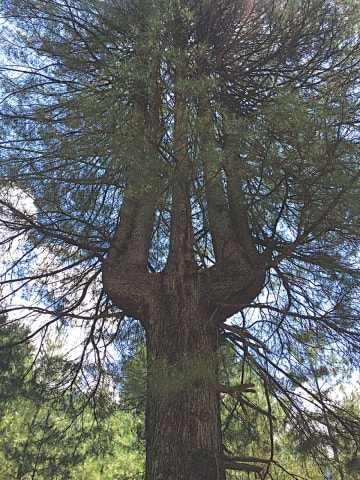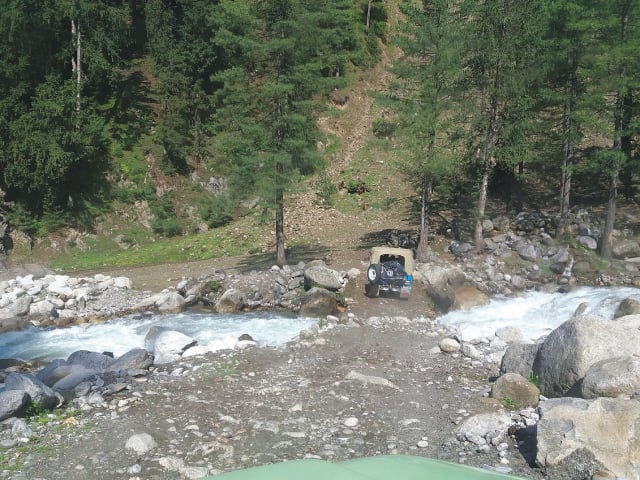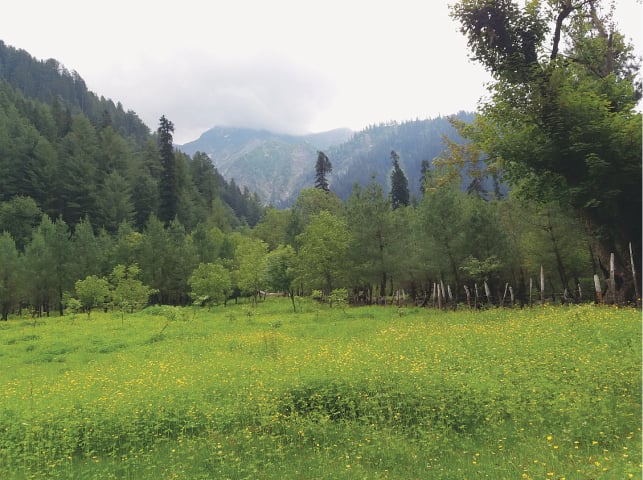If truth be told, it was the first time in years that I actually touched a butterfly. Vivaciously bright, they flit from one buttercup to another across the meadow overgrown with the yellow flowers that recall Wordsworth’s field of daffodils.
Beyari’s butterflies are worth all the trials it takes to reach their haven in the hills in the Kaghan Valley. The jeep ride along the almost non-existent road leading to the meadow has its travails, not the least being the process of unfolding your body upon reaching the destination after a cramped two-hour drive from the main road junction of Mahendari. It is said that the more cramped you are the better are the chances of stability, otherwise you would roll like boiled peas on a plate.
Driving on the luxurious main road between Naran and Kewai, the turn to Beyari is so inconspicuous that one has to be lucky not to miss it. And when you do manage the sharp turn, there is a distinct feeling of having bid au revoir to civilisation. With each turn of the road, the mountains close in upon you protectively and then suddenly the empty juice cartons, chips packages and flying shoppers, so ubiquitous in our urban lives, all disappear.
Manoor and Beyari in the Kaghan Valley are nearly untouched by civilisation and worth a trip
Beyari, the village named so because of the Beyar tree forests around it, is a mere half-a-dozen wooden shacks that stock food items, such as juices of unfamiliar brands and colourful biscuit packets. This is the last point from where you can buy edibles of any sort to last you for the next few days you plan to live in isolation, further on at the Manoor Conserve.

From here on, the terrain is rockier with high mountains on one side and deep gorges on the other. This track also opens up new vistas: of the rugged mountain spirit evident in the people and their pride in driving four-wheelers over and across boulders and gushing bridge-less mountain streams.
About half an hour after Beyari, a miracle happens. As you manoeuvre a bend, the mountains which had become quite menacingly overbearing suddenly open up to a majestic meadow. This is no mirage: Manoor, in July is a sight to be savoured. A tiny hut in the middle of a field of yellow buttercups surrounded by tree-covered mountains on all sides is the only material ornamentation under the azure blue sky.
A 90-minute trek up the eastern mountains, jumping over flowing streams and impenetrable forests, leads to an expanse designated as ‘protected’ by the department. There is a complete ban on tree-felling here and the area is declared no-go area to protect the flora. Animal grazing is also banned here to save the indigenous plants — that are not found elsewhere — being gobbled up by cattle.
Swirling around, one realises that the mountains have no opening — the embrace is total. Claustrophobic? Not at all. The beautiful completeness of Manoor Meadow is awe-inspiring. Having stepped into a goblet of buttercups at a height of 8,722 feet above sea level is euphoric. Surrounded by what appear to be the tall Monaal Mountains with the blue sky above is a view to be savoured for life. The Monaal range tops brood no rivalry, for not a single ridge rises above them.

The Manoor meadow is a take-off point for an interesting conservation project by the local forest department. Forest Officer Sajjad, whose enthusiasm would shame many a higher-up sitting in his air-conditioned urban office, is an asset for the tourist department because of his personal pride at conservation efforts which are being sustained in good measure by the locals.
A 90-minute trek up the eastern mountains, jumping over flowing streams and impenetrable forests, leads to an expanse designated as ‘protected’ by the department. There is a complete ban on tree-felling here and the area is declared a no-go area to protect the flora. Animal grazing is also banned here to save the indigenous plants — that are not found elsewhere — being gobbled up by cattle. The locals take a deep pride in the project. Sajjad shows a ‘snake plant’, a jealously-protected species, which is essential food for the Monaal area bears. Strongly sleep-inducing, the snake plant is essential for conserving the bear population and its hibernation habit.
Trekking around Monaal brings you face-to-face with some very intriguing sights such as the Monaal tree whose branches have grown to form the word “Allah!” As Sajjad proudly says, “There may be two like this in the world but not three!” Or the half-hour track to the Sango Lake, a small water body reached after a fascinating trek through lush green flora and fauna, dense woods of tall trees that close up behind your back, criss-crossing streams and picture-pretty resting points fashioned by nature.

Add another three hours on the track northwards and you reach the Aansoo Lake at a height of 5,023m. Named thus because the first people to ‘find’ it were an army patrol aircraft who were intrigued by the tear shape of the water body. It is said that before the discovery, even the locals did not know of its existence. In the summers the lake looks more like an eye with a tear drop flowing down a ridge.
Back at the Monaal meadow it’s time to head back to civilisation. The jeep driver puts on the four-wheel gear as you lurch homeward over rocks and boulders. Suddenly there is this desire to look back for one last glance at the field of buttercups but it’s not possible: Monaal meadow with its picturesque resthouse has shut itself away from prying eyes. The cupola of mountains stands guard, loath to let in intruders, pollution or urbanisation. This may be the reason I was able to touch a butterfly.
The writer is a freelance writer, and independent writing consultant at translator
Published in Dawn, EOS, September 10th, 2017














































